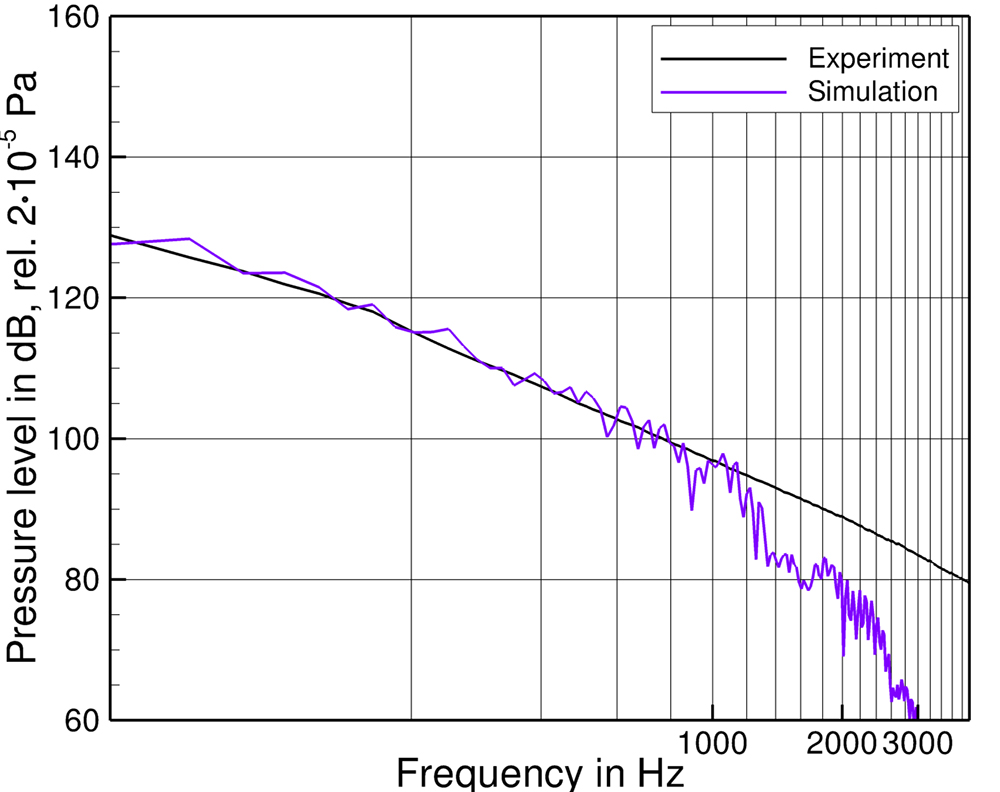ENGINEERING AND CFD
Direct Numerical and Large Eddy Simulation of Wall-Bounded Flows for Aeroacoustic Source Term Identification
Principal Investigator:
Christoph Scheit
Affiliation:
Lehrstuhl für Prozessmaschinen und Anlagentechnik, Friedrich-Alexander Universität Erlangen-Nürnberg (Germany)
Local Project ID:
pr86xe
HPC Platform used:
SuperMUC of LRZ
Date published:
In order to gain a deeper understanding of the aerodynamic noise generation mechanisms and transmission for automotive applications, researchers from the Universität Erlangen leveraged HPC system SuperMUC of LRZ to develop a hybrid aeroacoustic method. The turbulent flow over a forward-facing step served as a test case for the final validation of a hybrid scheme for the computation of broadband noise, as caused typically by turbulent flows.
Sound caused by flow plays a major role in different industrial applications. This is mainly due to the impact of noise emission and existing laws defining limits for noise levels. The present project „Direct numerical and large eddy simulation of wall-bounded flows for aeroacoustic source term identification“ had two main targets: the development of computational techniques for the prediction of flow generated sound, and the application of these techniques to model the noise caused by the flow around a side view mirror of a generic car model. For the latter also experimental data exists [1,2]. Simulations were carried out on SuperMUC [3] at LRZ Munich. Such a large scale supercomputer was necessary since the noise generation is mostly due to turbulence, which is still challenging to resolve and compute. All flow simulations have been carried out using Fastest-3D [6], the acoustic simulations were performed using CFS++ [7].
The turbulent flow over a forward facing step was considered as a test case for method development. This test case served for the final validation of a hybrid scheme for the computation of broadband noise, and the data can also be used in the future as reference for the further development of such methods. The flow has been computed using a direct numerical simulation, and Figure 1 shows isosurfaces of turbulent pressure fluctuations. Small structures are generated in the vicinity of the step and merge downstream of the step and are convected downstream of the step where they merge to larger structures again. Clearly, a highly turbulent flow field is caused by the step. Figure 2 shows the spectrum obtained from the simulation compared to a measured spectra from measurements in an anechoic wind tunnel. As can be seen, good agreement has been achieved up to high frequencies.

Figure 1: Isosurfaces of turbulent pressure fluctuations p’, bright isosurfaces are for -9 Pa, and dark for 9 Pa [4].
Copyright: Lehrstuhl für Prozessmaschinen und Anlagentechnik, FAU Erlangen-Nürnberg
Figure 2: Computed vs. measured acoustic spectrum in 1 meter distance above the step edge.
Copyright: Lehrstuhl für Prozessmaschinen und Anlagentechnik, FAU Erlangen-NürnbergThe second part of the project was concerned with the application of the developed hybrid acoustic scheme to the flow around a simplified car model. The turbulent flow around the model was computed using a Large Eddy Simulation. To illustrate the instantaneous flow and the developing structures behind the a-pillar and the generic side view mirror, isosurfaces of the turbulent pressure fluctuations are visualized in Figure 3. A great variety of sizes of the vortex structures can be observed and also very small structures have been resolved by the simulation. On various points on the side window, local pressure values were gathered and compared in frequency and amplitude to experimental data. Figure 4 shows the spectrum of these wall pressure fluctuations at a point in the wake behind the side view mirror. A good agreement between simulation and experimental data can be observed up to a frequency of 1200 Hz.
Altogether a hybrid aeroacoustic method has been developed within the present project. The method was validated successfully for the turbulent flow over a forward-facing step. By the developed hybrid method and the conducted simulations it is now possible to get deeper insight into the aerodynamic noise generation mechanisms and transmission for automotive applications by the use of supercomputing.

Figure 3: Isosurfaces of turbulent pressure fluctuations p‘, for p’=p±20 Pa
Copyright: Lehrstuhl für Prozessmaschinen und Anlagentechnik, FAU Erlangen-Nürnberg
Figure 4: Spectrum of wall-pressure fluctuations at a position in the wake of the side view mirror.
Copyright: Lehrstuhl für Prozessmaschinen und Anlagentechnik, FAU Erlangen-NürnbergReferences and Links
[1] S. Müller, S. Becker, C. Gabriel, R. Lerch, F. Ullrich “Flow-induced input of sound to the interior of a simplified car model depending on various setup parameters.“ In: AIAA Aeroacoustics Conference 2013
[2] Forschungsverbund FORLärm, Bayerische Forschungsstifgung
[4] C. Scheit, „Hybrid Aeroacoustic Methods for Broadband Noise Calculation.” Submitted as PhD thesis, Friedrich-Alexander-University Erlangen-Nuremberg
[5] K. Nusser, S. Müller, C. Scheit, M. Oswald and S. Becker: “Large Eddy Simulation of the Flow Around a Simplified Car Model.” In: Direct and Large-Eddy Simulation X, 2015, Limassol. To appear in: Direct and Large-Eddy Simulation X, Springer
[6] F. Durst and M. Schäfer: “A Parallel Block-Structured Multigrid Method for the Prediction of Incompressible Flows.” In: Int J. Num. Methods Fluids, 22:549–565, 1996
[7] M.Kaltenbacher, “Numerical Simulation of Mechatronic Sensors and Actuators.” Springer, 3rd edition, 2015
Scientific Contact:
Christoph Scheit
Lehrstuhl für Prozessmaschinen und Anlagentechnik
Friedrich Alexander Universität Erlangen-Nürnberg
Cauerstrasse 4, D-91058 Erlangen (Germany)
e-mail: sh [@] ipat.uni-erlangen.de